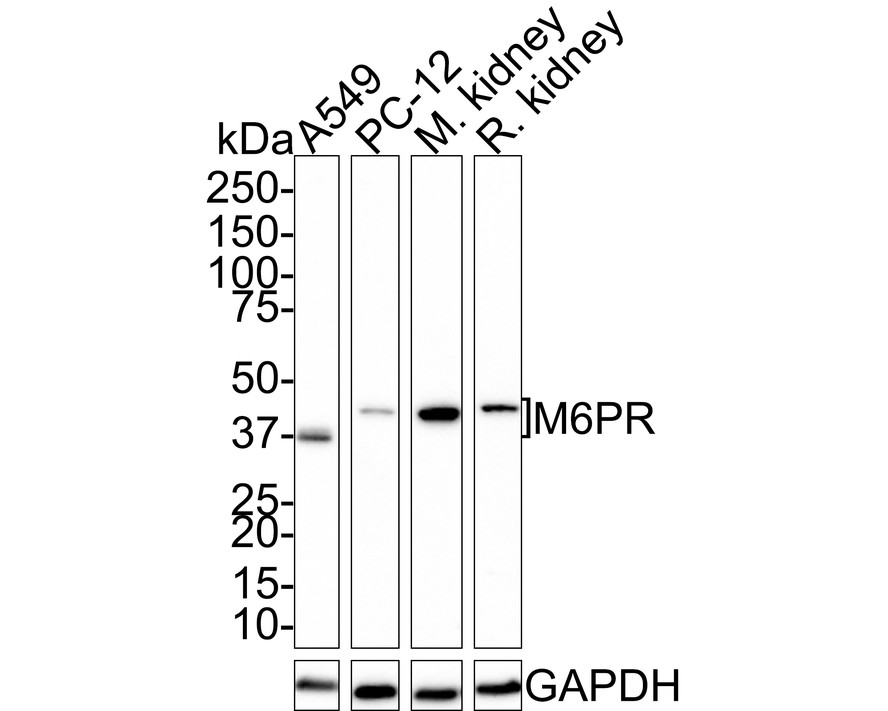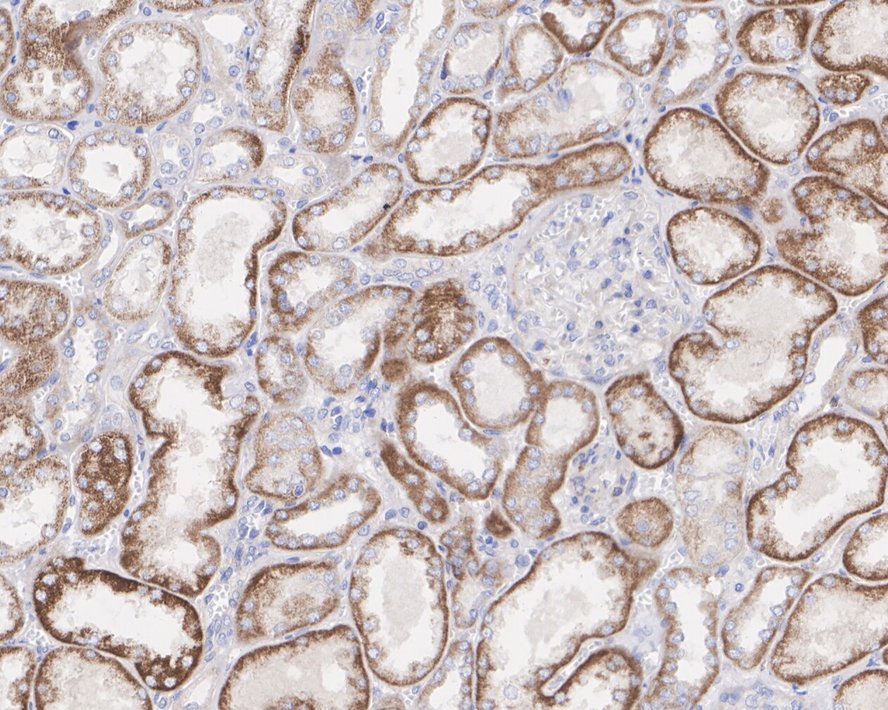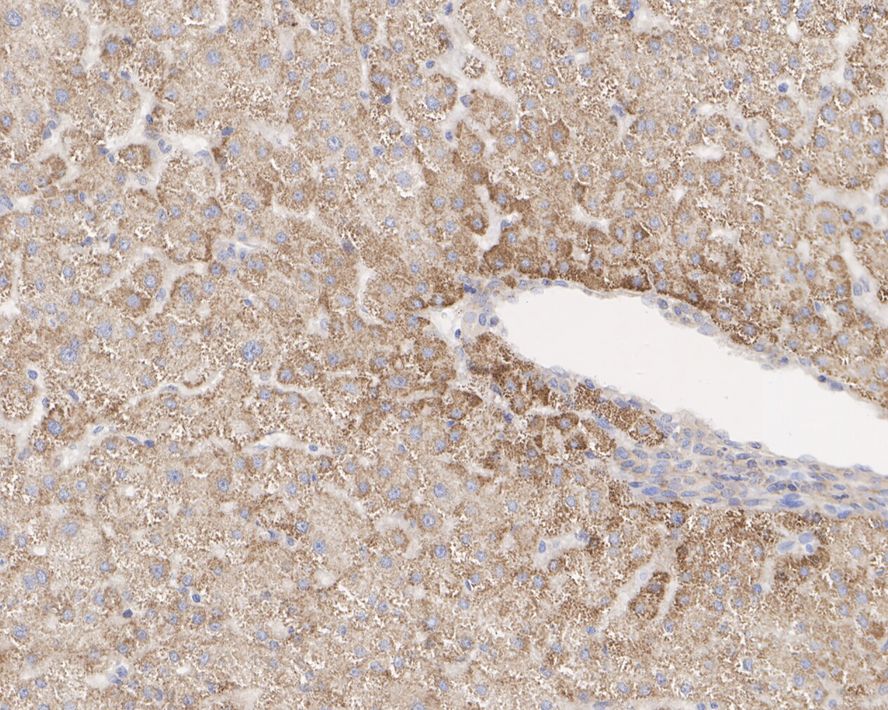M6PR (cation dependent) Recombinant Rabbit Monoclonal Antibody [PSH01-06]

cat.: HA721571
| Product Type: | Recombinant Rabbit monoclonal IgG, primary antibodies |
|---|---|
| Species reactivity: | Human, Mouse, Rat |
| Applications: | WB, IHC-P |
| Clonality: | Monoclonal |
| Clone number: | PSH01-06 |
| Form: | Liquid |
| Storage condition: | Shipped at 4℃. Store at +4℃ short term (1-2 weeks). It is recommended to aliquot into single-use upon delivery. Store at -20℃ long term. |
| Storage buffer: | PBS (pH7.4), 0.1% BSA, 40% Glycerol. Preservative: 0.05% Sodium Azide. |
| Concentration: | 1ug/ul |
| Purification: | Protein A affinity purified. |
| Molecular weight: | Predicted band size: 31 kDa |
| Isotype: | IgG |
| Immunogen: | Recombinant protein within human M6PR aa 1-200 / 277. |
| Positive control: | A549 cell lysate, PC-12 cell lysate, mouse kidney tissue lysate, rat kidney tissue lysate, human kidney tissue, human liver tissue, rat kidney tissue. |
| Subcellular location: | Lysosome membrane. |
| Recommended Dilutions:
WB IHC-P |
1:1,000 1:200-1:1,000 |
| Uniprot #: | SwissProt: P20645 Human | P24668 Mouse | Q6AY20 Rat |
| Alternative names: | 46 kDa mannose 6 phosphate receptor 46 kDa mannose 6-phosphate receptor Cation dependent mannose 6 phosphate receptor Cation dependent mannose 6 phosphate receptor precursor Cation-dependent mannose-6-phosphate receptor CD Man 6 P receptor CD Man-6-P receptor CD MPR CD-M6PR CD-MPR FLJ32994 M6pr M6PR protein Man6PR Mannose 6 phosphate receptor (cation dependent) Mannose 6 phosphate receptor MPR 46 MPR46 MPRD MPRD_HUMAN Mr 46,000 Man6PR Small mannose 6 phosphate receptor SMPR |
Images

|
Fig1:
Western blot analysis of M6PR (cation dependent) on different lysates with Rabbit anti-M6PR (cation dependent) antibody (HA721571) at 1/1,000 dilution. Lane 1: A549 cell lysate (20 µg/Lane) Lane 2: PC-12 cell lysate (20 µg/Lane) Lane 3: Mouse kidney tissue lysate (40 µg/Lane) Lane 4: Rat kidney tissue lysate (40 µg/Lane) Predicted band size: 31 kDa Observed band size: 37/46 kDa Exposure time: 3 minutes; 4-20% SDS-PAGE gel. Proteins were transferred to a PVDF membrane and blocked with 5% NFDM/TBST for 1 hour at room temperature. The primary antibody (HA721571) at 1/1,000 dilution was used in 5% NFDM/TBST at room temperature for 2 hours. Goat Anti-Rabbit IgG - HRP Secondary Antibody (HA1001) at 1:100,000 dilution was used for 1 hour at room temperature. |

|
Fig2:
Immunohistochemical analysis of paraffin-embedded human kidney tissue with Rabbit anti-M6PR (cation dependent) antibody (HA721571) at 1/1,000 dilution. The section was pre-treated using heat mediated antigen retrieval with Tris-EDTA buffer (pH 9.0) for 20 minutes. The tissues were blocked in 1% BSA for 20 minutes at room temperature, washed with ddH2O and PBS, and then probed with the primary antibody (HA721571) at 1/1,000 dilution for 1 hour at room temperature. The detection was performed using an HRP conjugated compact polymer system. DAB was used as the chromogen. Tissues were counterstained with hematoxylin and mounted with DPX. |

|
Fig3:
Immunohistochemical analysis of paraffin-embedded human liver tissue with Rabbit anti-M6PR (cation dependent) antibody (HA721571) at 1/200 dilution. The section was pre-treated using heat mediated antigen retrieval with Tris-EDTA buffer (pH 9.0) for 20 minutes. The tissues were blocked in 1% BSA for 20 minutes at room temperature, washed with ddH2O and PBS, and then probed with the primary antibody (HA721571) at 1/200 dilution for 1 hour at room temperature. The detection was performed using an HRP conjugated compact polymer system. DAB was used as the chromogen. Tissues were counterstained with hematoxylin and mounted with DPX. |

|
Fig4:
Immunohistochemical analysis of paraffin-embedded rat kidney tissue with Rabbit anti-M6PR (cation dependent) antibody (HA721571) at 1/200 dilution. The section was pre-treated using heat mediated antigen retrieval with Tris-EDTA buffer (pH 9.0) for 20 minutes. The tissues were blocked in 1% BSA for 20 minutes at room temperature, washed with ddH2O and PBS, and then probed with the primary antibody (HA721571) at 1/200 dilution for 1 hour at room temperature. The detection was performed using an HRP conjugated compact polymer system. DAB was used as the chromogen. Tissues were counterstained with hematoxylin and mounted with DPX. |
Note: All products are “FOR RESEARCH USE ONLY AND ARE NOT INTENDED FOR DIAGNOSTIC OR THERAPEUTIC USE”.